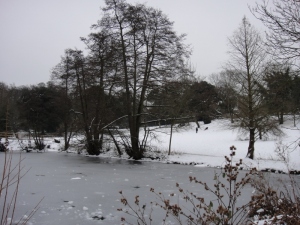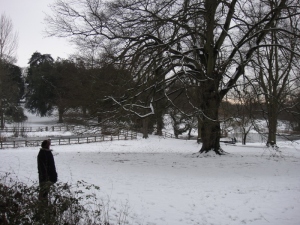It was a freezing cold day when we rocked up at Holywells Park in Ipswich to try to find the ‘hermit’s mossy cell’ as described by Elizabeth Cobbold in her poem ‘Holy Wells’ that inspired my Legend of the Holy Wells. Snow lay everywhere around, and children were racing while chilly parents followed them. It wasn’t easy to see what we were looking at, but it certainly showed what a vibrant place the former grounds of Elizabeth’s house has become.
Why is it called Holywells? Well, shh, let me tell you a secret … it was called Hollow Wells (1) before , and our romantic 19th century citizens changed Hollow to Holy – maybe Elizabeth herself coining the term. The place does have a religious history, however, as it was owned by the Bishops of Norwich. There may possibly have been a residence for the bishops, and potentially a small chapel – but the idea of a Bishop’s Palace may well also have been concocted by Elizabeth! She seems to have been a woman after my own heart – keen to enchant, or re-enchant the landscape around her.
Is there any possibility that Elizabeth’s story has a grounding in history? The importance of the water on the site doesn’t seem to have been celebrated until the Cobbold’s came along to use it in their beer making in the 17th century. But there have certainly long been rumours of something holy happening at Holywells. Was it a guardian of the wells? A guardianship handed down from father to son over the generations? Had there, in fact, been a guardian there since the Iron Age and the time of the druids? A friend of Boudicca, maybe? We’ll never know – unless archaeology does turn something up in the future.
But, what about those Vikings? They were there, right? Oh yes. On the 5 May in 1010 there was a battle at Nacton, and indeed there is a snippet of folklore about the area. The Seven Hills mounds at Nacton – there are actually eight, and there were thirteen or fourteen once – by the A1156 are supposed to be the graves of the Saxons who fought under Ulfcytel Snillinge, or the Bold, Ealdorman of East Anglia, and who were killed by the invading Vikings under Thorkell the Tall (2).
In the saga of St Olaf, the Heimkringla, East Anglia is Ulfketel’s Land. He seems to have ruled from 1002 until his death in 1016. He may have been married to a daughter of King Ethelred. The Saxon forces in the battle at Nacton did not cover themselves with glory however. Thorketel Mare’s Head ran away, taking his force with him, and only the men of Cambridgeshire held firm. The Vikings then sack Ipswich, and raid the region.
But there are Vikings on both sides. This is a war for the rule of the country, not random raids to take plunder. Ulfketel and Thorketel are Scandinavian sounding names, and fighting on Ethelred’s side was also St Olaf, Olaf Haraldsson, the king who brought Christianity to Norway. And it’s complicated. The ‘enemy’ is Sweyn Forkbeard, and one of the reasons he felt able to invade was that his sister Gunhilde was said to have been killed as part of the St Brice’s Day Massacre on 13 November 1002, when Ethelred ordered all Danes (Vikings!) in England killed as he was afraid they might come after his throne – he was afraid that the Danes were ‘sprouting like cockle amongst the wheat’. Of course, his plan backfired and led to his overthrow, not once, but twice – badly counselled indeed! And an early indicator of the effects of an intolerant political agenda towards migrants. The Danes in Oxford, for example, sought refuge in a church, and were burnt out and killed. Who is the bad guy here? Can we tell? Can we judge – I doubt they could judge at the time, and I doubt we can judge now even with hindsight.
The battles continued. The same year at Rymer in Suffolk (seven miles south of Thetford, near RAF Honington and indeed another Seven Hills with mounds…) there was another battle in which St Olaf fought alongside Ulfketel:
To Ulfkel’s land came Olaf bold,
A seventh sword-thing he would hold.
The race of Ella filled the plain —
Few of them slept at home again!
Hringmara heath
Was a bed of death:
Harfager’s heir
Dealt slaughter there.
From Hringmara field
The chime of war,
Sword striking shield,
Rings from afar.
The living fly;
The dead piled high
The moor enrich;
Red runs the ditch.(3)
Ethelred won this one, and Ulfketel attempted to make a truce with Sweyn, but he broke it and tried to sack Thetford. This jockeying went on until St Edmund (allegedly) killed Sweyn in 1014, revenging himself on the Danes who had taken his life, and perhaps incensed that Sweyn had chosen the same day to get crowned as himself – Christmas day. But that’s another story for another blog. His son Cnut took the throne in 1016, after the battle that killed Ulfketel. It is said that he was killed by his nemesis at Nacton, the Jomsviking Thorkell.
A complex tale indeed, and who’s to say that two wounded Vikings didn’t make their way to Ipswich and that one found his long lost Saxon father and stayed as a hermit guarding the holy well…
There is a certain irony to all this, though. Because there is a Viking age holy well in Ipswich. A boundary charter of 970 records a haligwille near the Stoke area on the other side of the Orwell, probably where Fir Tree Farm was, and where the Chantry Estate now is. The well was already well enough established to be used as boundary marker:
The aforesaid land is bounded this way and that by these limits : ‘These are the boundaries (landgemaera) of the 10 hides at Stoke. The first of these is a hythe and along the midstream at Ashman’s yre and so forth into the middle of the stream it comes to brunna and so forth to Theofford and from there to Haligwille to Healdenesho and so to Pottaford to Hagenefordabrycge from Hagenefordabricgeto Horsewade to [into] a merscmylne from merscmylne to the bridge In the year of the Lord’s incarnation the nine hundred and seventieth was this charter written.’(4)
It may have been in use for a long time before, as it is close to the place where a cache of Iron-age gold torcs was found in 1968 – a ritual offering? The mystery deepens…
Notes:
1. http://www.gatehouse-gazetteer.info/English%20sites/4278.html
2. Actually Bronze Age bowl barrows…
3. http://omacl.org/Heimskringla/ The text of this edition is based on that published as “Heimskringla: A History of the Norse Kings” (Norroena Society, London, 1907, and edited, proofed, and prepared by Douglas B. Killings, April 1996
4. Fairclough, John ‘The Bounds of Stoke and the Hamlets of Ipswich’ in Proceedings of the Suffolk Institute of Archaeology & History Volume XL, part 3 (2003), pp. 262-277





